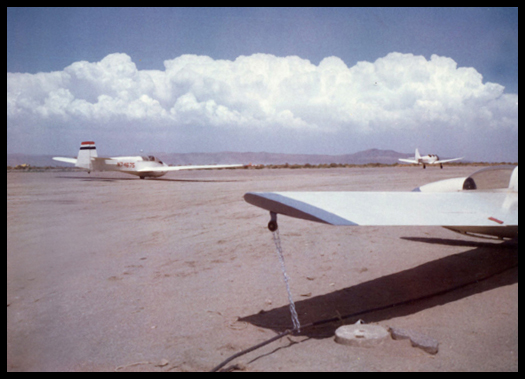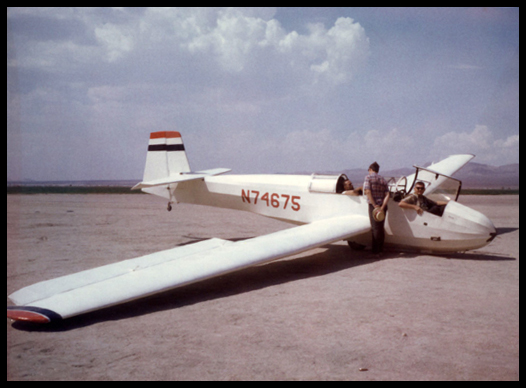
Two-Four Fox, the family plane, was due for its annual inspection. My favorite mechanic was at Orange County Airport; the plane was hangared at Torrance, 40 miles away. As with an automobile, you occasionally have to make arrangements for someone to drive you home from the repair shop. With an airplane, it's better to fly. I called Mike. Ever meet a guy who knows everything? That's Mike. In his field, "systems software," there wasn't anybody at the time who knew more. He did some work for my company as a consultant. We talked flying. Rather, Mike talked; I listened. By his middle twenties, he knew everything about flying, too. Mike bought a 1968 Skylane, just like mine, only yellow. He flew out of Orange County. I had no contact with Mike, once his contract ran out. But that Saturday I needed a lift. "Come glider flying with me," said Mike over the phone. "I'll drop you off on my way back from Crystalaire." "Sure," I said
without much heart. I had already taken one lesson in
a sailplane and had little affection for the sport
"You're not a real pilot until you know how to fly without an engine," Mike advised. We arranged to meet on the ramp in front of the maintenance hangar at Orange County. I persuaded my son to come with me. It was no big deal for Harv -- no bigger deal than for any other eleven-year-old being dragged along to drop off the family stationwagon for a lube job. Only the promise of a flight in a sailplane gained his assent. At the appointed time, Mike taxied up. The yellow Skylane was altogether magnificent. I tried not to notice. Mike shut down the engine and stepped out. "Just had it waxed," said he, backing toward me. I offered my hand. Mike never took his eyes off the plane. He bent forward to catch a glint. "You should wax yours, you know." He pulled a cotton cloth from his hip pocket and wiped gently at some imperfection on the engine cowling. "Nice bird," said I, dropping my hand unshaken. I introduced my son. Mike said he was glad to meet him. Harv had reason to doubt that. "Watch your feet getting in," Mike cautioned. "Don't kick the wheel fairings." "We both took showers this morning," I said with a chuckle. Mike was not amused. "You ever flown gliders?" "At Tehachapi last summer," I said. "If I can find an instructor, this will make my second lesson." "What about him?" asked Mike, cocking his head toward my son. Harv chose to speak for himself. "Sailplanes, you mean. I've been up in sailplanes plenty." Mike motioned for us to get into the plane. "We're missing some thermals," he said. Flying sailplanes is a hobby best suited for people with airplanes. You have to go out into the boonies to do it. Crystalaire is in the high desert north of Los Angeles. Our trip in the yellow Skylane took more than an hour. In a car it would have required three. Soon after landing, Mike ensconced himself in a blue single-seater with drooping wings and was towed aloft to play in the sky. We wouldn't see him again until the middle of the afternoon. I made arrangements for Harv to go for a ride. Not untypically,
there was a lot of waiting around for an available
instructor. I bought a book entitled Gliding
and sat down at a picnic table in the sun. Harv chased
after a lizard. The book fell open to a chapter on
wind gusts...
About 1:00 PM, Harv got his turn with a young instructor named Jeff. I waved and watched as the tow-plane powered up and tugged away a venerable wood-and-fabric something-or-other with my son inside.
Roped together, the two aircraft
struggled in unison out of the dust and into the sky.
I hoped Jeff, who couldn't have been older than
twenty, was a competent pilot. I went back to my book.
I wanted to learn about wind-shear...
The wind was picking up. I watched what turned out to be my son's glider being tossed about as it approached. Harv called out to me from the open canopy. "Your turn." We strapped ourselves in, with Jeff in back.
The flight instruments were on a small panel in front of me. I remember wondering how Jeff would be able to see them. The tow-plane taxied by and a ground crew member hooked up the rope. Our sagging wings were already fidgeting in the wind. "Your son told me this will be your second lesson," Jeff commented, as the line pulled taut. "Don't get sick, okay?" Immediately after liftoff, we found ourselves being jerked around behind the tow-plane. Turbulence is endemic to glider flying. After all, you seek up-slope winds, lee waves, and thermals -- the very conditions most sensible pilots try to avoid. By the end of this lesson, I would have another reason not to recommend the sport. As instructed, I pulled a lever to release the line at 4,000 feet. The tow-plane peeled off into a spiraling descent. Jeff had me trim for 50 knots. "One point three times stall speed, okay?" With his coaching, I began making turns this way and that, handling controls badly, at times. Jeff must not have been able to see the turn-and-slip indicator or he would have corrected my technique. Just as likely, it was the turbulence and the flexing wings that concealed my clumsiness. Jeff and I had no luck finding "lift" so we jounced our way back across a desert valley into the landing pattern. "See those little doors on top of the wings?" Jeff hollered. "They're called spoilers. I'll pull 'em about halfway up. That way if we start to overshoot our landing point, we just pull on the rest of the spoilers and down we go, like closing the throttle on your Cessna, okay?" From that day's experience and others, I've come to distrust sentences that end with "okay?" The airspeed was the same as what we set up earlier for cruising, 50 knots. I asked Jeff about that. "I already explained. That's 30% over stall speed, okay?" We turned onto base leg perpendicular to the runway, crabbing askew through the air. I see dust clouds on the ground. That surface wind must be 30 knots or more. I decided to speak up. "Uh, this book I was just reading says you should fly your approaches faster than minimum drag speed -- " "Why would you want to do that?" Jeff interrupted. "It's only relative wind that matters, okay?" We turned final, still at 50 knots. I could feel the gusts. "Well, if there are gusts or wind-shear -- " "That's what I'm trying to show you with the spoilers, okay?" Jeff seemed to be in no mood for a lesson from his student. At a couple hundred feet above the ground, the wind was so strong, it nearly stopped our forward motion. We were undershooting badly. "Watch this," said Jeff. "I dump the spoilers, just like pushing in the throttle -- " "Dumping the spoilers won't do it!" I interrupted as the airspeed started to fall. The last time I looked, the needle was swinging below 40 knots. Jeff let out a cry. "What the -- !" He must have lost his presence of mind, for he yanked back on the stick. The glider didn't respond. With a shudder, the nose fell through and we plunged the last 50 feet. That's four stories, people. There were three sounds. A cracking noise -- that was the hull absorbing the impact. I heard a zipping sound, and I felt each of my vertebrae yielding in sequence from the bottom up, while my face plummeted toward the control stick in my lap. Finally, I shall never forget the thud of Jeff's head striking the back of my seat. I vaguely recall sitting up, surprised to see that we were still moving. We were rolling on gravel, drifting to the left. Instinctively, I jammed the right rudder pedal. Too much; we dug in the left wing and stopped at an angle. Jeff came to, as the ground crew reached us. He moaned unintelligibly. Somebody lifted the canopy and released my seat belt. I crawled out of the cracked fuselage and stood part way up, arms akimbo. Everything on me that starts with the letter "b" hurt. A member of the ground crew commented disapprovingly about the damaged wing. Jeff pressed a handkerchief against a cut above his hairline. He was laughing now, glad to be alive. My disposition reached a low point. I made uncomplimentary remarks to Jeff, Bernoulli, and God. Son Harv strolled up, sheltering an ice cream bar from the wind using my new book on gliding. He gestured over his shoulder. "Your friend Mike wants to leave," he said. "We're supposed to meet him at the plane." He inspected the damaged glider. "Augured in," he mused. "Gimme that book." Jeff was limping toward the flight office. I trudged up beside him and started hollering above the sound of the wind and the ringing in my ears. I impolitely lectured the post-adolescent on the difference between a spoiler, which affects lift, and an engine-driven propeller, which provides thrust. Jeff tried in vain to reply. Shoving the book into his hands, I suggested at the top of my voice that, before he ever presumed to go aloft again with the intention of being paid for his knowledge, he might study the chapter on wind-shear. "You will find particularly edifying the passage about 'nose-down approach-stalls'." I stomped away with Harv at my side. Mike was ready to start the engine. He watched warily as Harv finished his ice-cream bar before taking his seat in the yellow Skylane. I grimaced climbing aboard. "What's wrong with you," asked Mike unsympathetically. "Wind-shear," explained my son from the back seat. Mike revved the engine and we taxied toward the run-up pad. "You mean 'down-draft', " he said. "Harv's right," I interjected, rubbing my temples. "We got a bad dose of wind-shear on approach." "Down-drafts," said Mike with finality. "I had 'em too on my last ride. What were you in?" My son gave Mike the model number of the sailplane. "I flew it first," Harv said. "We had down-drafts a lot." Mike taxied onto the gravel strip and powered up. "What happened to the sled?" "It really got pranged," shouted Harv, pounding his fist into his open hand. The choppy turbulence tormented my bludgeoned body after take-off. I waited until we reached smooth air before speaking. "Mike, we were too close to the runway to have a down-draft." "You can get down-drafts anywhere." "Not unless the ground is exceptionally porous," I countered. Mike looked puzzled. "Where's a down-draft supposed to go when it hits the surface?" I asked. Mike leveled off at 8,500 for the trip to Torrance. I vainly sought comfort by reclining my seat. "What airspeed were you carrying on final?" asked Mike. "We flew 50 for the whole trip." "That was your problem," he said. "Yeah," agreed my son. I wanted to speak, but not enough to put out the effort. During the flight back to Torrance, Mike treated me to a tutorial on sailplane aerodynamics. By the time we began our descent over the Santa Monica Mountains, I had grown weary of the implication in front of my son that I utterly lacked the fundamentals of unpowered flight. "The only way to deal with down-drafts," Mike concluded, "is to push the nose down and get more airspeed." "You can't do that just by dumping spoilers," I said for my son's benefit. I raised my voice. "But Mike, I'm telling you it was wind-shear out there on final not a down-draft. It was wind-shear that stalled us out and gave me this pain where the sun don't shine." Mike called Torrance Tower from over LAX. I started to cite the chapter in Gliding, but he cut me off. "You can't believe everything you read." We turned downwind at Torrance. I hurt too much to care. By convention, the pilot in command occupies the left seat and has authority over all aspects of flight. The person in the right seat may have delegated tasks, but otherwise enjoys no status. Unsolicited comments are decidedly unwelcome, often dangerous. A qualified pilot riding as a passenger must exercise utmost restraint. Such was the case on that downwind leg at Torrance. First, I noticed that Mike had us at 800 feet. Fine for Orange County, but the pattern altitude at Torrance is 1,100 feet. Then too, there was the approach speed: Mike was trimmed for 65 knots, not the 70 that I always use. I didn't say anything, of course. Still plenty of margin, plenty of time to correct. Mike acknowledged a radio call and hung up his mike. We were number three to land. That means extending our landing pattern over the refinery at Lomita, a routine situation on weekends. Those of us who fly out of Torrance know about that refinery and the heat it puts out.
Airplanes over Lomita on final for Torrance feel a momentary uplifting -- an exhilaration from this invisible column of rising air. Unfamiliar pilots misjudge the effect and reduce power to avoid overshooting the runway.
We all know what cold air does. It shrinks and sinks, of course, and on calm days some of the warm air in the updraft over the refinery gets drawn back down over the bean field. Yes, a down-draft. Mike, ever the sailplane pilot, closed the throttle. "We don't need that noise anymore," said he confidently. Airspeed was just below 60. Exhilaration came and went as we glided over Lomita. Mike hung out full flaps. A little early for that, I thought to myself. Airspeed now under 55 and Mike doesn't notice. He is gaping at the bean field coming up to meet us. His hand moves from the flap handle back to the throttle. Airspeed falling below 50. He can save it with the engine -- if his pride will let him. No way can we make the runway now without power. Mike's hand trembles. Pride wins. "What the -- !" Mike cries. The second time I've heard those words today. We hit the bean field nose-high and sank. Green, wet stalks appeared above the cowling. The yellow Skylane's landing gear flexed and sprang back. We popped up for a glimpse of the runway, then down again. The propeller harvested some more beans. On the second bounce we caught the asphalt apron and rolled onto the runway. Instinctively, Mike applied heavy braking. We stopped on the numbers -- at the beginning of the runway. My pains were as nothing. "Not bad," said I sincerely. My son piped up in language unbecoming an eleven-year-old. "What the hell happened?" "That's what I want to know," exclaimed Mike. Torrance Tower called with instructions to expedite our taxi: "Forward to the first turn-off, please. Traffic on half-mile final." For a long moment, we just sat there on the runway, Mike glowering straight ahead through the windshield. I could see bean stalks hanging off the wing strut. I determined not even to smile. The plane behind us was waved off by the tower. Mike finally pushed in the throttle. Scraping sounds came from the main gear. We taxied to the ramp outside our hangar and Mike shut down the engine. I started to hurt again. Mike paced around the plane at a distance of ten feet, frowning. His magnificent yellow bird had been baptized in beans and mud. I offered Mike Two-Four Fox's hangar and an automobile ride back to Orange County. He said that his plane was flyable. Who was I to argue with him? He borrowed our hose to clean the mud out of the wheel fairings. My son and I got into the car. "That," I called out to Mike,
"was a down-draft."
|

